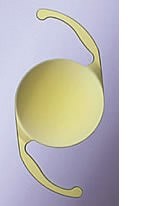What is Astigmatism?
Astigmatism occurs when the cornea is shaped more like a football rather than a soccer ball. Most astigmatic corneas have two curves—a steeper curve and a flatter curve. This causes light to focus on more than one point in the eye, resulting in blurred vision at distance and near. Uncorrected astigmatism causes ghosting or shadowed images.
How is Astigmatism corrected?
Astigmatism can corrected non-surgically or surgically. Non-surgical options include glasses or toric contact lens. Our advanced surgical techniques and intraocular lens allow for highly precise correction, often reducing or eliminating the need for glasses.
Remember, these lens are good for life.
Surgical Options for Astigmatism
Limbal Relaxing Incision
Limbal Relaxing Incision (LRI) is a surgical procedure to treat astigmatism. It is often combined with cataract surgery to reduce pre-existing astigmatism. The result is better vision without glasses. During surgery tiny incisions are placed on the periphery of the cornea (called the limbus) resulting in a cornea that is more rounded. The procedure can be completed in a few minutes. There is usually little if any post-operative discomfort.
Limbal relaxing incisions have gained widespread acceptance among cataract surgeons, resulting in better post-operative vision without glasses. The procedure can also be performed separate from cataract surgery in individuals whose primary refractive error is astigmatism.
Monofocal Toric IOLs
 Another option to reduce astigmatism are monofocal toric intraocular lens (IOLs). These lens reduce the patient’s need for glasses in the distance. In fact the patient may only need over the counter reading glasses. Without this lens, patients would need prescription glasses for distance and prescription glasses to read. There is a big difference between needing prescription reading glasses and over the counter reading glasses.
Another option to reduce astigmatism are monofocal toric intraocular lens (IOLs). These lens reduce the patient’s need for glasses in the distance. In fact the patient may only need over the counter reading glasses. Without this lens, patients would need prescription glasses for distance and prescription glasses to read. There is a big difference between needing prescription reading glasses and over the counter reading glasses.
Vivity Toric IOLs
Vivity Toric Intraocular lens (IOLs) are an example of a new type of IOL called an extended depth of focus (EDOF) lens. These are intraocular lens that both correct astigmatism and provide a wider range of clear vision compared to a standard monofocal toric lens. Instead of focusing at just one distance, an EDOF lens is designed to smoothly extend your focus from distance to intermediate with some near vision. Unlike multifocal toric lens, there are no increase risk of glare and halos compared to the standard monofocal toric intraocular lens.
Light Adjustable Lens (LALs)
A Light Adjustable Lens (LAL) is a special type of intraocular lens that allows the astigmatism to be fine tuned or corrected after cataract surgery. Unlike traditional lens such as the vivity toric or the monofocal toric, this lens can be precisely adjusted with painless light treatments 1-2 months after cataract surgery. This delivers the highest level of accuracy and personalization available. To learn more about this revolutionary new lens, click on the Light Adjustable Lens link.
Dr. Stuart Kaufman, Dr. Jonathan Kaufman, and Dr. Chelsey Krambeer will evaluate your eyes and discuss which lens are best suited for your unique eyes and lifestyle.


